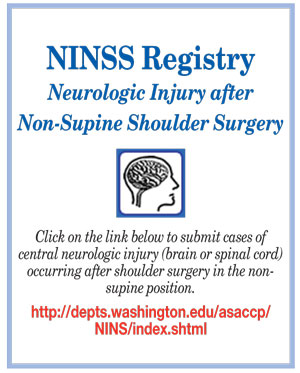![]() The APSF Newsletter has published numerous articles over the last 2 years on severe brain and spinal cord injuries occurring after shoulder surgery in the sitting or beach chair position. Many of these cases have been associated with the use of deliberate or permissive hypotension, typically at the request of surgeons, to decrease bleeding and improve visualization during arthroscopic shoulder surgery. Several theories exist as to the etiology of these catastrophic neurologic injuries including 1) the loss of venous return and decreased cardiac output in the upright position; 2) loss of a compensatory sympathetic response to positional changes caused by anesthesia; 3) failure to correct for the difference in height between the site of blood pressure measurement and the head level; 4) the use of deliberate or permissive hypotension; 5) dynamic vertebral artery stenosis or occlusion with rotation of the head; and 6) air emboli. These articles have generated significant interest and alarm among the anesthesia and orthopedic communities. Many groups have reported by word of mouth a change in surgical and anesthetic practice based on this information. However, many anesthesia care providers are still being faced with surgical requests for deliberate hypotension in these cases, because of the sparsity of data on this topic.
The APSF Newsletter has published numerous articles over the last 2 years on severe brain and spinal cord injuries occurring after shoulder surgery in the sitting or beach chair position. Many of these cases have been associated with the use of deliberate or permissive hypotension, typically at the request of surgeons, to decrease bleeding and improve visualization during arthroscopic shoulder surgery. Several theories exist as to the etiology of these catastrophic neurologic injuries including 1) the loss of venous return and decreased cardiac output in the upright position; 2) loss of a compensatory sympathetic response to positional changes caused by anesthesia; 3) failure to correct for the difference in height between the site of blood pressure measurement and the head level; 4) the use of deliberate or permissive hypotension; 5) dynamic vertebral artery stenosis or occlusion with rotation of the head; and 6) air emboli. These articles have generated significant interest and alarm among the anesthesia and orthopedic communities. Many groups have reported by word of mouth a change in surgical and anesthetic practice based on this information. However, many anesthesia care providers are still being faced with surgical requests for deliberate hypotension in these cases, because of the sparsity of data on this topic.
 The APSF Board of Directors Workshop, held last October in New Orleans, further explored this potentially lethal, yet preventable, patient safety issue by inviting numerous national and international experts on the topics of cerebral perfusion, cerebral function monitoring, deliberate hypotension, and shoulder surgery. Most speakers and attendees agreed that the use of deliberate hypotension in these shoulder surgery cases in the sitting position should be discouraged until we have better research on this topic. One of the suggestions for future research from the breakout groups at the workshop was to create a national voluntary registry to collect these rare cases of neurologic injury after non-supine surgery (NINSS).
The APSF Board of Directors Workshop, held last October in New Orleans, further explored this potentially lethal, yet preventable, patient safety issue by inviting numerous national and international experts on the topics of cerebral perfusion, cerebral function monitoring, deliberate hypotension, and shoulder surgery. Most speakers and attendees agreed that the use of deliberate hypotension in these shoulder surgery cases in the sitting position should be discouraged until we have better research on this topic. One of the suggestions for future research from the breakout groups at the workshop was to create a national voluntary registry to collect these rare cases of neurologic injury after non-supine surgery (NINSS).
In follow-up to the workshop recommendations, the APSF has funded the creation of the NINSS Registry in collaboration with the ASA Closed Claims Project at the University of Washington. It will be modeled after the ASA Postoperative Visual Loss Registry, with the goal of identifying common perioperative characteristics that may guide future research. Prior to data from the ASA Postoperative Visual Loss Registry, the anesthesia community was being blamed for inadequate protection of patient eyes in the prone position resulting in blindness. With the voluntary efforts of anesthesiologists, nurse anesthetists, and some patients, enough data were collected to identify that the most common cause of postoperative visual loss after spine surgery was being caused by something other than globe compression. Once this information was well dispersed, other perioperative events and characteristics began to emerge as potential predisposing risk factors, such as duration of surgery and magnitude of blood loss.
The NINSS Registry is a voluntary registry collecting all cases of new or worsened central (brain or spinal cord) neurologic injury after shoulder surgery in the non-supine position. The injury must occur either during surgery or within the initial 24 hrs postoperatively; and the minimum patient age is 12 years. Exclusion criteria include 1) any case where direct surgical trauma could cause cerebral or spinal cord injury; 2) perioperative cardiac arrest, intraoperative hypoxic events, or uncontrolled surgical hemorrhage; 3) lack of adequate medical records including preoperative history and exam, anesthetic record, and postoperative follow-up and studies. Case submissions are voluntary and anonymous, with IRB approval for this study from the University of Washington. Please visit our website at www.asaclosedclaims.org and click on the brain and spinal cord icon to direct you to submission forms. The direct link is http://depts.washington.edu/asaccp/NINS/index.shtml. It is only with the help of our dedicated professionals in the anesthesia community that we can collect enough information to offer guidance on the topic of blood pressure management in the beach chair position.
Dr. Lee is Co-Editor of the APSF Newsletter, Director of the NINSS Registry, and Associate Professor of Anesthesiology at the University of Washington, Seattle, WA.


 Issue PDF
Issue PDF